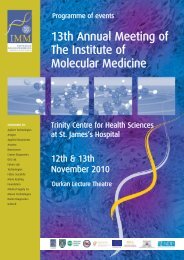Guidelines on Diagnosis and Treatment of Malignant Lymphomas
Guidelines on Diagnosis and Treatment of Malignant Lymphomas
Guidelines on Diagnosis and Treatment of Malignant Lymphomas
Create successful ePaper yourself
Turn your PDF publications into a flip-book with our unique Google optimized e-Paper software.
Mantle Cell Lymphoma<br />
Definiti<strong>on</strong> <strong>and</strong> incidence<br />
Mantle cell lymphoma (MCL) is a B-cell neoplasm composed <strong>of</strong><br />
m<strong>on</strong>omorphic small to medium sized lymphoid cells with irregular<br />
nuclei which most closely resemble centrocytes/ follicle centre<br />
cells but with less-irregular nuclei. MCL accounts for 3-10% <strong>of</strong><br />
n<strong>on</strong>-Hodgkin lymphomas, occurring predominantly in middleaged<br />
or older individuals (median age 63) with an incidence <strong>of</strong><br />
0.72 cases/100,000/year <strong>and</strong> a male: female ratio <strong>of</strong> 5:1.<br />
ICD – O Code 9673/3<br />
Clinical Presentati<strong>on</strong><br />
Patients usually present with enlarged lymph nodes at multiple<br />
sites <strong>and</strong> frequently a massively enlarged spleen. B<strong>on</strong>e marrow<br />
involvement with occasi<strong>on</strong>al leukaemic spill is present in 80% <strong>of</strong><br />
patients. Waldeyer’s Ring <strong>and</strong> the gastrointestinal tract are<br />
frequent extra-nodal sites <strong>of</strong> involvement. Lymphomatous<br />
polyposis <strong>of</strong> the gastrointestinal tract is a form <strong>of</strong> mantle cell<br />
lymphoma <strong>and</strong> can occur as variably-sized polyps in any part <strong>of</strong><br />
the gastrointestinal tract.<br />
Pathology <strong>and</strong> Genetics<br />
MCL shows architectural destructi<strong>on</strong> by a m<strong>on</strong>omorphic<br />
lymphoid proliferati<strong>on</strong> with a vaguely nodular or mantle z<strong>on</strong>e<br />
growth pattern. Many cases have scattered single epithelioid<br />
histiocytes which can produce a ‘starry sky’ appearance.<br />
Hyalinized small blood vessels are comm<strong>on</strong>ly seen. Disease<br />
progressi<strong>on</strong> or relapse is characterised by an increase in nuclear<br />
size, pleomorphism, nuclear chromatin dispersal <strong>and</strong> an increase<br />
in mitotic activity. Blastoid variants with cells resembling<br />
lymphoblasts <strong>and</strong> a high mitotic index are associated<br />
with a worse prognosis.<br />
Immunophenotype<br />
The neoplastic cells are m<strong>on</strong>ocl<strong>on</strong>al B-cells with intense surface<br />
IgM+/- IgD. They are CD19+ve, CD20+ve, CD5+ve, FMC7+ve<br />
<strong>and</strong> CD10-ve <strong>and</strong> express Cyclin D1. Cases with gastrointestinal<br />
involvement express the alpha4B7 homing receptor.<br />
Genetics<br />
MCL is defined by the presence <strong>of</strong> the t(11;14)(q13;q32)<br />
resulting in juxtapositi<strong>on</strong> <strong>of</strong> CyclinD1 <strong>and</strong> the IgH gene which<br />
leads to upregulati<strong>on</strong> <strong>of</strong> CyclinD1. The translocati<strong>on</strong> can be<br />
detected reliably by FISH <strong>and</strong> in about 40% <strong>of</strong> cases by PCR.<br />
Staging<br />
Staging <strong>of</strong> disease, if nodal, can be reported using the Ann Arbor<br />
classificati<strong>on</strong>, but is clearly not appropriate for extranodal<br />
presentati<strong>on</strong> such as multiple lymphomatous polyposis.<br />
Recommended Investigati<strong>on</strong>s<br />
Generic: see page 2<br />
Specific<br />
Gastrointestinal endoscopy (if appropriate)<br />
BMA <strong>and</strong> trephine, with immunophenotyping<br />
<strong>and</strong> FISH / PCR if marrow involved.<br />
30
















